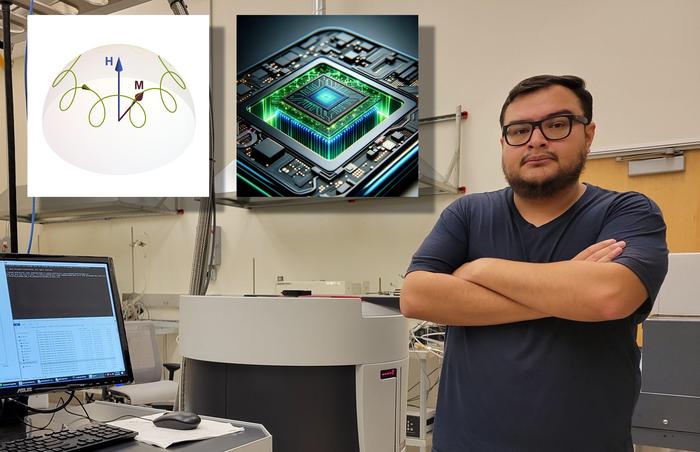Making ferromagnets ready for ultra-fast communication and computation technology
RIVERSIDE, Calif. — An international team led by researchers at the University of California, Riverside, has made a significant breakthrough in how to enable and exploit ultra-fast spin behavior in ferromagnets. The research, published in Physical Review Letters and highlighted as an editors’ suggestion, paves the way for ultra-high frequency applications. Credit: Barsukov lab, UC Riverside. RIVERSIDE, […]

RIVERSIDE, Calif. — An international team led by researchers at the University of California, Riverside, has made a significant breakthrough in how to enable and exploit ultra-fast spin behavior in ferromagnets. The research, published in Physical Review Letters and highlighted as an editors’ suggestion, paves the way for ultra-high frequency applications.

Credit: Barsukov lab, UC Riverside.
RIVERSIDE, Calif. — An international team led by researchers at the University of California, Riverside, has made a significant breakthrough in how to enable and exploit ultra-fast spin behavior in ferromagnets. The research, published in Physical Review Letters and highlighted as an editors’ suggestion, paves the way for ultra-high frequency applications.
Today’s smartphones and computers operate at gigahertz frequencies, a measure of how fast they operate, with scientists working to make them even faster. The new research has found a way to achieve terahertz frequencies using conventional ferromagnets, which could lead to next-generation communication and computation technologies that operate a thousand times faster.
Ferromagnets are materials where electron spins align in the same direction, but these spins also oscillate around this direction, creating “spin waves.” These spin waves are crucial for emerging computer technologies, playing a key role in processing information and signals.
“When spins oscillate, they experience friction due to interactions with electrons and the crystal lattice of the ferromagnet,” said Igor Barsukov, an associate professor of physics and astronomy, who led the study. “Interestingly, these interactions also cause spins to acquire inertia, leading to an additional type of spin oscillation called nutation.”
Barsukov explained that nutation occurs at ultra-high frequencies, making it highly desirable for future computer and communication technologies. Recently, physicists’ experimental confirmation of nutational oscillations excited the magnetism research community, he said.
“Modern spintronic applications manipulate spins using spin currents injected into the magnet,” said Rodolfo Rodriguez, the first author of the paper, a former graduate student in the Barsukov Group, and now a scientist at HRL Labs, LLC.
Barsukov and his team discovered that injecting a spin current with the “wrong” sign can excite nutational auto-oscillations.
“These self-sustained oscillations hold great promise for next-generation computation and communication technologies,” said coauthor Allison Tossounian, until recently an undergraduate student in the Barsukov Group.
According to Barsukov, spin inertia introduces a second time-derivative in the equation of motion, making some phenomena counterintuitive.
“We managed to harmonize spin-current-driven dynamics and spin inertia,” he said. “We also found an isomorphism, a parallel, between the spin dynamics in ferromagnets and ferrimagnets, which could accelerate technological innovation by exploiting synergies between these fields.”
In ferrimagnets, usually two antiparallel spin lattices have an unequal amount of spin. Materials with antiparallel spin lattices recently received increased interest as candidates for ultrafast applications, Barsukov said.
“But many technological challenges remain,” he said. “Our understanding of spin currents and materials engineering for ferromagnets has significantly advanced over the past few decades. Coupled with the recent confirmation of nutation, we saw an opportunity for ferromagnets to become excellent candidates for ultra-high frequency applications. Our study prepares the stage for concerted efforts to explore optimal materials and design efficient architectures to enable terahertz devices.”
The title of the paper is “Spin inertia and auto-oscillations in ferromagnets.”
The study was supported by the National Science Foundation.
The University of California, Riverside is a doctoral research university, a living laboratory for groundbreaking exploration of issues critical to Inland Southern California, the state and communities around the world. Reflecting California’s diverse culture, UCR’s enrollment is more than 26,000 students. The campus opened a medical school in 2013 and has reached the heart of the Coachella Valley by way of the UCR Palm Desert Center. The campus has an annual impact of more than $2.7 billion on the U.S. economy. To learn more, visit www.ucr.edu.
Journal
Physical Review Letters
DOI
10.1103/PhysRevLett.132.246701
Method of Research
Experimental study
Subject of Research
Not applicable
Article Title
Spin Inertia and Auto-Oscillations in Ferromagnets
Article Publication Date
13-Jun-2024
COI Statement
Authors have no conflict of interest.
What's Your Reaction?

































